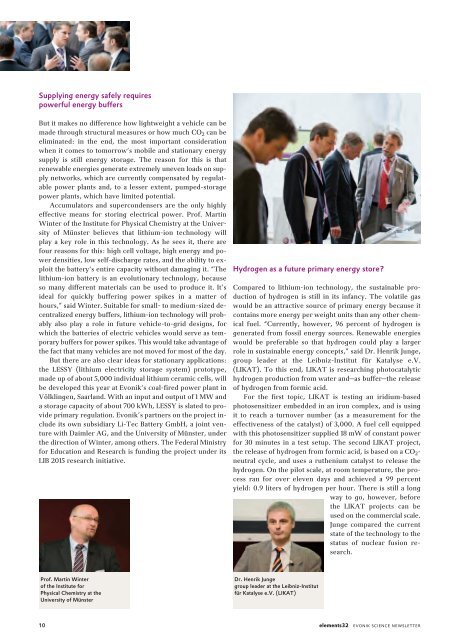Download - Evonik Industries
Download - Evonik Industries
Download - Evonik Industries
You also want an ePaper? Increase the reach of your titles
YUMPU automatically turns print PDFs into web optimized ePapers that Google loves.
Supplying energy safely requires<br />
powerful energy buffers<br />
But it makes no difference how lightweight a vehicle can be<br />
made through structural measures or how much CO 2 can be<br />
eliminated: in the end, the most important consideration<br />
when it comes to tomorrow‘s mobile and stationary energy<br />
supply is still energy storage. The reason for this is that<br />
renew able energies generate extremely uneven loads on supply<br />
networks, which are currently compensated by regulatable<br />
power plants and, to a lesser extent, pumped-storage<br />
power plants, which have limited potential.<br />
Accumulators and supercondensers are the only highly<br />
effective means for storing electrical power. Prof. Martin<br />
Winter of the Institute for Physical Chemistry at the Uni versity<br />
of Münster believes that lithium-ion technology will<br />
play a key role in this technology. As he sees it, there are<br />
four reasons for this: high cell voltage, high energy and power<br />
densities, low self-discharge rates, and the ability to exploit<br />
the battery‘s entire capacity without damaging it. “The<br />
lithium-ion battery is an evolutionary technology, because<br />
so many different materials can be used to produce it. It’s<br />
ideal for quickly buffering power spikes in a matter of<br />
hours,” said Winter. Suitable for small- to medium-sized decentralized<br />
energy buffers, lithium-ion technology will probably<br />
also play a role in future vehicle-to-grid designs, for<br />
which the batteries of electric vehicles would serve as temporary<br />
buffers for power spikes. This would take advantage of<br />
the fact that many vehicles are not moved for most of the day.<br />
But there are also clear ideas for stationary applications:<br />
the LESSY (lithium electricity storage system) prototype,<br />
made up of about 5,000 individual lithium ceramic cells, will<br />
be developed this year at <strong>Evonik</strong>‘s coal-fired power plant in<br />
Völklingen, Saarland. With an input and output of 1 MW and<br />
a storage capacity of about 700 kWh, LESSY is slated to provide<br />
primary regulation. <strong>Evonik</strong>’s partners on the project include<br />
its own subsidiary Li-Tec Battery GmbH, a joint venture<br />
with Daimler AG, and the University of Münster, under<br />
the direction of Winter, among others. The Federal Ministry<br />
for Education and Research is funding the project under its<br />
LIB 2015 research initiative.<br />
Prof. Martin Winter<br />
of the Institute for<br />
Physical Chemistry at the<br />
University of Münster<br />
Hydrogen as a future primary energy store?<br />
Compared to lithium-ion technology, the sustainable production<br />
of hydrogen is still in its infancy. The volatile gas<br />
would be an attractive source of primary energy because it<br />
contains more energy per weight units than any other chemical<br />
fuel. “Currently, however, 96 percent of hydrogen is<br />
generated from fossil energy sources. Renewable energies<br />
would be preferable so that hydrogen could play a larger<br />
role in sustainable energy concepts,” said Dr. Henrik Junge,<br />
group leader at the Leibniz-Institut für Katalyse e.V.<br />
(LIKAT). To this end, LIKAT is researching photocatalytic<br />
hydrogen production from water and—as buffer—the release<br />
of hydrogen from formic acid.<br />
For the first topic, LIKAT is testing an iridium-based<br />
photosensitizer embedded in an iron complex, and is using<br />
it to reach a turnover number (as a measurement for the<br />
effectiveness of the catalyst) of 3,000. A fuel cell equipped<br />
with this photosensitizer supplied 18 mW of constant power<br />
for 30 minutes in a test setup. The second LIKAT project,<br />
the release of hydrogen from formic acid, is based on a CO2 neutral cycle, and uses a ruthenium catalyst to release the<br />
hydrogen. On the pilot scale, at room temperature, the process<br />
ran for over eleven days and achieved a 99 percent<br />
yield: 0.9 liters of hydrogen per hour. There is still a long<br />
way to go, however, before<br />
the LIKAT projects can be<br />
used on the commercial scale.<br />
Junge compared the current<br />
state of the technology to the<br />
status of nuclear fusion research.<br />
Dr. Henrik Junge<br />
group leader at the Leibniz-Institut<br />
für Katalyse e.V. (LIKAT)<br />
10 elements32 evonik science newsletter

















